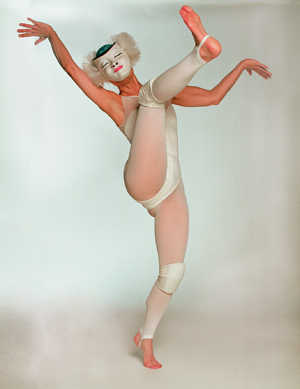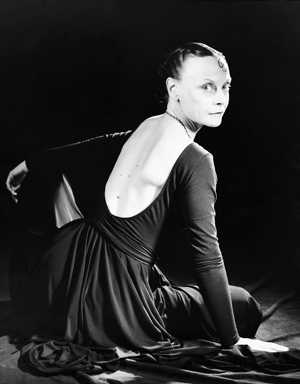Ritual in Motion, Unmasking the Secrets of the Body Through The Thinking Body, The Feeling Mind®
When you step over the threshold of Linda Lack’s Two Snakes Studios on La Cienega Boulevard where she teaches her signature technique of The Thinking Body, The Feeling Mind®, there is an immediate feeling of entering sacred ritual space. The front entryway floor is paved with small stones, providing the feeling of shifting realities from the sometimes unconscious frenzy of Los Angeles traffic in all directions. The back room, which serves as another entrance into the studio space, is adorned with masks and collections of art, stage sets, and handmade treasures bestowed on Lack from students around the world.
The practice space in the middle is open and expansive, with mirrors that allow students to reflect on what they are thinking and feeling, observing, adjusting and integrating. Before class begins, people familiar with the routine collect mats that they cross over each other, double up, or pair with circular mats to accommodate the many flowing, repetitive and circular movements that cross different spatial planes and are integral to Lack’s fusion technique.
The Thinking Body, The Feeling Mind® is a movement modality that is interdisciplinary, explorative and simultaneously scientific. It combines familiar postures from Hatha Yoga, Lack’s extensive background in dance performance, kinesiology (the science of movement), a sophisticated understanding of the capabilities of the body and therapeutic applications of physicality of breath, motion and meditation. Through the use of progressively linked sequences that gently awaken and warm up the joints, the movements intelligently allow the body to not merely move into a shape, but to actually create the energetic expression of what it feels like to be in a dialogue between all the levels and layers of the body and mind. This is not to say that it is necessarily a gentle technique, although is certainly accessible to all levels of practitioner and skill with the physical body. It is a technique that is therapeutic and educational at its very core, teaching us how we can live from the inside out. For this reason, Lack teaches in all levels of the professional Yoga Therapy training program at Loyola Marymount University, as well as other programs far and wide.
One of the key aspects of this technique is attitude, an attitude that comes through in class, and one that both long-time and novice students remark upon when asked about their relationship with the practice. This is the attitude of asking permission of the body, rather than making demands. Setting demands, often extreme ones, is a trap that we can all fall into, as people living in these bodies, whether we’re performing to meet our everyday demands, performing on a stage, or in front of a camera, as Lack herself and many of her students have past or present experience doing. She has trained modern dancers, prepared people for Cirque de Soleil auditions and humbly calls herself honored and privileged to have mentored or served as a teacher or movement therapist to a “diverse community of surgeons, modern-day circus and physical theater performers, rock musicians, lawyers, actors, CEOs, street dancers, teachers/colleagues, and just regular people wanting to live well in body-mind.” She’s counted four generations in families who have walked through her studio door, who have studied with her at various stages of health and disease and different levels of learning how to best ask the body for permission in order to live vibrantly at their full potential
 When she performs, she herself embodies this attitude of permission, and of dialogue. In her work, she frequently cloaks herself in handcrafted masks from cultures around the world. Rather than cover and conceal, the masks reveal hidden relationships and connections. In many of her performance rituals, she partners with the persona of an animal, a spirit or any of the expressions and creatures of the natural world. In her graceful sinuousness, she models the feeling of what it is to be a wolf, for example. Through her unabashedly personal choreography, she boldly makes political statements about the nature of our relationship with the world around us, the Earth whom we are in a dialogue with as profound as the dialogue we speak with our breath. She has such a strong belief in ritual that she identifies herself as a ritualist. Lack feels that we don’t plan enough rituals in our lives today, so she creates ritual dance “for births, deaths and everything in between.”
When she performs, she herself embodies this attitude of permission, and of dialogue. In her work, she frequently cloaks herself in handcrafted masks from cultures around the world. Rather than cover and conceal, the masks reveal hidden relationships and connections. In many of her performance rituals, she partners with the persona of an animal, a spirit or any of the expressions and creatures of the natural world. In her graceful sinuousness, she models the feeling of what it is to be a wolf, for example. Through her unabashedly personal choreography, she boldly makes political statements about the nature of our relationship with the world around us, the Earth whom we are in a dialogue with as profound as the dialogue we speak with our breath. She has such a strong belief in ritual that she identifies herself as a ritualist. Lack feels that we don’t plan enough rituals in our lives today, so she creates ritual dance “for births, deaths and everything in between.”
Whether she is performing, teaching, ordering food for lunch, engaging in conversation with students or attending a reception, through her own balanced carriage and graceful movement, she embodies, no more than that, she transmits the experience of what it means to be at home in this human form. And she does so with an innate creativity. For Lack the ritualist, performance is more than simply performance, but ritual in action. And class is more than class, as it is also the experience of learning how to embody what it is to practice the ritual of being engaged in a relationship with the self-and of forming community. This then becomes our entire life.
It has certainly become Lack’s entire life: this exploration of what is really means to have a life in which the rituals of breath and movement are expansive and joyful. This rigorous study led her to pursue a masters degree in dance in UCLA and PhD in movement/education/healing from Union Institute and University. Her interest in the body and its interconnected communication runs deep, and her research examines the differences between primary or pure movement, dance as art and translated experience—that which we express through words and language. These interconnections are ones that she has explored since she felt the pull in childhood toward dance as an art form and means of expression. Dance, as she points out, is ephemeral. It only exists if it is actually being done. A piece of choreography only lives as it is performed. The linked movements that are passed on from one dancer to another provide a relational code that both inspires and informs us. It is a transmission that occurs through all movement forms, through Yoga, through dance, through the therapeutic understanding of what it means to live in this body. It is analogous to how we actually live our lives, in this moment, in this breath, in this Thinking Body, Feeling Mind®.
Linda Lack teaches The Thinking Body, The Feeling Mind® at Two Snakes Studio in Los Angeles. She offers small weekly group classes, teaches individual and therapeutic sessions and mentors teachers in teacher training programs to learn this technique. Linda Lack will be leading her annual immersion experience of The Feeling Body, The Thinking Mind® in Idyllwild, California, November 5 – 8. For more information on classes, individual sessions, research, performances, teacher training and more, visit: lindalack.com.
By Felicia Marie Tomasko, RN
Felicia Tomasko has spent more of her life practicing Yoga and Ayurveda than not. She first became introduced to the teachings through the writings of the Transcendentalists, through meditation, and using asana to cross-train for her practice of cross-country running. Between beginning her commitment to Yoga and Ayurveda and today, she earned degrees in environmental biology and anthropology and nursing, and certifications in the practice and teaching of yoga, yoga therapy, and Ayurveda while working in fields including cognitive neuroscience and plant biochemistry. Her commitment to writing is at least as long as her commitment to yoga. Working on everything related to the written word from newspapers to magazines to websites to books, Felicia has been writing and editing professionally since college. In order to feel like a teenager again, Felicia has pulled out her running shoes for regular interval sessions throughout Southern California. Since the very first issue of LA YOGA, Felicia has been part of the team and the growth and development of the Bliss Network.

